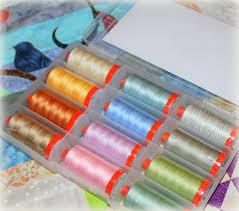Greetings fellow quilters and Welcome to Part II of our 2016 Free Motion Quilt Along.
If you're just joining us be sure to checkout these prior blog posts:
Introduction => click here
Sponsors => click here
Supplies => click here
Part I Pieced Borders => click here
Many thanks to our fantastic sponsors including:
Aurifil
Quilter's Dream Batting
World of Susybee
Creekside Fabrics, Quilts and Yarns
Sew It Is Quilt Shop
Quilty Pleasures Quilt Shop
They've provided some awesome products for Giveaways -- to learn more click here.
Aurifil
Quilter's Dream Batting
World of Susybee
Creekside Fabrics, Quilts and Yarns
Sew It Is Quilt Shop
Quilty Pleasures Quilt Shop
They've provided some awesome products for Giveaways -- to learn more click here.
This week we're preparing the quilt layers and pin basting.
Why Baste?
Proper basting technique is essential to avoid tucks, folds, or puckers in your fabrics. It also helps to ensure your flimsy (quilt top) stays somewhat square, and will fit within the batting and backing layers without shifting.If you do a good job of basting, you can avoid puckers and folds on the back. If you're a bit sloppy or go without basting - you take your chances.
The basting process can be completed many different ways -- I prefer pin basting with curved safety pins.
There are many alternatives to pin basting including: basting with straight pins, using straight pins with caps or anchors (brand name Pinmoor), basting with needle and thread by hand or machine, or basting with an adhesive spray.
Personally I avoid spray baste because I'm ultra sensitive to chemicals and aerosol... and really -- as you'll see from the video clips, I enjoy the process of pin basting. I use the opportunity to study and think about how to quilt a particular fabric or flimsy I'm working with.
Another possible pitfall to basting with adhesive spray is the potential for it to flatten your batting, therefore limiting the loft you see in your quilting. I've seen some quilt sandwiches sprayed excessively with adhesive to the point where there was no texture left to the beautiful wool batting. If you Spray Baste, avoid that pitfall.
Pin Basting - The Process
For Part II of the 2016 FMQ Along I've created two videos and Pin Basting basics tutorial with images and text below. If you're new to basting, be sure to review the tutorial AND the videos before you begin the process.Preparation
Cut backing & batting 1.5" to 2" wider than quilt top on each side.Let your flimsy be a guide for sizing up the quilt backing and batting.
I normally rough cut my backing with shears followed by trimming the straight with a rotary cutter.
Using pinking shears or a pinked rotary blade will reduce fray.
Having a straight edge helps with the taping process.
Be sure the top and the backing fabric are pressed well.
No need to worry about stubborn creases, they'll work out in the quilting!
Check batting and fabrics for stray threads that might show through the fabric once quilted. Especially dark threads - Remove as necessaryIf you have a table large enough -- use it! Otherwise consider using the floor, or visiting your local quilt shop, community center or library for this step.
*
Gather up tape to secure the backing -- I love using the 3m Blue Tape. It adheres just fine but also peels away without taking finish off the table.
Secure the Quilt Backing
After pressing, position the quilt back face-down on a flat surfaceTape along a single long edge, using 3M Blue Tape. Secure to the surface taping every few inches.
Prepare to tape the opposite long edge.
Below I'm showing the ripples that exist before you tape the opposite side.
NOTE: It's important to pull the batting taut and remove all the waffles or puckers from it to avoid folds or puckers in your quilting.
From the other side of the backing, smooth the fabric, pulling taut and tape it in position.
Once you've secured both long edges, those ripples should be GONE!
Continue the same on the top and bottom of the quilt.
Pull taut but DO NOT STRETCH or DISTORT your quilt back.
One the backing is taut and secured :
Add batting and quilt top layers
Layer batting, one at a time, smoothing from the center outward as you go.
If you're using two layers of batting, use the higher loft batting on top -- for example, in my sample I used Quilter's Dream Cotton on the bottom and Quilter's Dream Wool on top.
Putting the loft toward the quilt top will help build dimension in your quilt stitches -- you will love it!
NOTE: I DO NOT tape or secure the batting -- after smoothing it rests flat on the quilt top.
NOTE: I never press or put a hot iron on a quilt once the batting is layered.
Because I rely heavily on 100% wool batting, I avoid using a hot iron or steam that may flatten the woolen fibers.
Flatten the quilt top starting in the center and smoothing from the center outward
Checkout the Pin Basting Prep video tutorial by clicking the image below:
We're ready to Pin!
Over the years, I've acquired several sizes of Dritz Quilting Curved Safety Pins. I tend to use the 1" version more than the larger ones. Using smaller pins reduces the number of times I need
to stop and remove a pin ;)
Let's get pinning!
Begin pinning in the center of the quilt with a curved pin -- be sure to pin through all 3 (or 4) layers.Between each pin be sure to smooth outward from the center.
(see video)
Masure a fist-width spacing between each pin.
Work in a circular fashion from the center outward -- smoothing outward and pinning as you go.
Have you tried the Kwik Klip tool? It's a great way to get your pins closed
without stressing your fingers (or your fingernails). I purchased mine years ago -- give it a try. If you don't have one readily available, try the blunt end of a small crochet hook.
That works too!
It's effective to put several pins in before going back and closing them.
Try it out - it saves time to do pinning and then closing in batches.
Moving on -- continue smoothing outward and pinning as you go.
Checkout the Pin Basting video tutorial by clicking the image below:
Some tips for pinning:
Try to pin in the middle of a subject area or block. On our panel I avoid pinning near the edge of Lewe or any of the Balloons. Anticipate where you'll be quilting first and avoid those areas.Always smooth an area outward before placing a pin. You want to be sure your top fabric is smooth to avoid puckers or tucks.
Consider using a Kwik Klip tool to aid in the closing and opening of the pins.
Congratulations!
As the sun drops behind the Keuka Bluff our pin basting is complete.
What next ?
A bit later this week I'll be posting a "How to Quilt That" video to discuss the quilt motif ideas that spin in my head while I'm pin basting... Stay tuned for that.
I also owe you a bit more about the tools I use to FMQ. If you want a sneak peek into those tools click here.
It's getting exciting -- soon we'll be learning motifs and quilting away!
Are you ready ?
Does this help ?
Thanks for your feedback.
Cheers!
Karen






























































